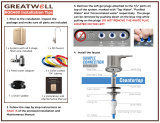
Customer Service Hotline 1-877-693-PURE
Page 9
Home Master® Reverse Osmosis System—Owners Manual
few things you can do. A) Disconnect the red drain line from the drain saddle, adjust the red
tube protruding from the nut (add a little more or reduce it), while ensuring there is at least
some visible red tube protruding, and reconnect. B) Empty your P trap to ensure the system
waste water isn't dropping into standing water. C) Use a common rubber stopper to cover your
sink’s drain opening to muffle the sound.
Weak pressure at RO faucet & Reserve tank filling slowly
NOTE: Seasonal changes in temperature can cause pressure imbalances within the
system resulting in slow water production. Oftentimes the imbalance will correct itself
on its own within a few days. You may also restore the internal system pressure
balance by draining the tank, unplugging the tubing from the automatic shut off valve
(ASV—shown to the right), then allow the system to stand open overnight. Then
reconnect, open the feed valve, and allow the tank to refill.
Weak pressure is either a storage problem or a production problem. To determine which
close the tank valve and open the RO faucet. After a brief burst, you should see a steady thin
trickle of water, or a trickle that pulses on and off -if you have the permeate pump. If this is
what you see then it’s a storage tank problem. If you see zero water, or only a few broken
drops then it’s a production problem.
Storage tank problems:
1. Make sure storage tank is full, and has been flushed at least twice.
2. Make sure the angle-stop is wide open.
3. Check all tubing for kinks or sharp bends - this can impede the flow of water.
4. Check reserve tank air pressure. Tank MUST be empty of water, tank valve OPEN, system
feed valve CLOSED and RO faucet OPEN. Air valve is located on the side of the tank under a
cap. Use a bicycle tire pressure gauge. Tank should have 7.5 psi when empty of water. If
the pressure is less, then add air using a bicycle pump. Do not overfill. If the tank does not
hold the air then the tank is bad and should be replaced
Production problems
1. Check flow to the membrane housing. Close water at the feed water adapter
and tank, and briefly open the RO faucet at the sink to relieve any system pressure. Then
pull the black tube out of the top of the blue membrane housing at the quick connect fitting.
(There is only one fitting on the top of the membrane housing, the bottom has two - one
white, one grey). Point the tube you have just disconnected into a pitcher and turn on the
EZ adapter valve. The water flow from the tube should be fairly strong.
2. If the flow to the membrane housing is strong, then check the water flow exiting both the
white elbow and the grey elbow at the bottom of the membrane housing. The water flow
from the white elbow should be a thin, but steady trickle, and the flow from the grey elbow
should be greater than the white elbow . If the flow from the grey elbow is less than the
white than it should be replaced. If there is no flow from either then change the membrane
and the grey elbow. Please note that the minimum water pressure for the system to
operate is 40psi. Also remember to inspect your drain line where the red tube connects to
the drain saddle, and you can also unscrew the grey elbow at the bottom of the membrane
housing. If gunk is obstructing the drain line, then the system cannot produce good water.
3. If the flow to the membrane housing is weak, then start working your way backward and




















